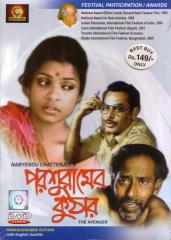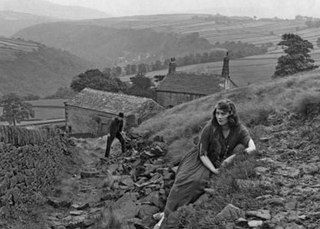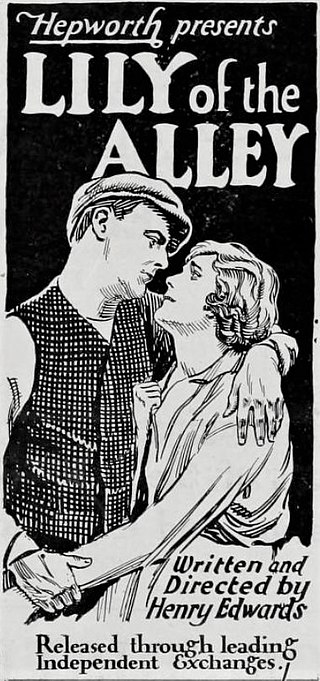
A wet nurse is a woman who breastfeeds and cares for another's child. Wet nurses are employed if the mother dies, or if she is unable or chooses not to nurse the child herself. Wet-nursed children may be known as "milk-siblings", and in some societies, the families are linked by a special relationship of milk kinship. Wet-nursing existed in societies around the world until the invention of reliable formula milk in the 20th century. The practice has made a small comeback in the 21st century.

Cecil Milton Hepworth was a British film director, producer and screenwriter. He was among the founders of the British film industry and continued making films into the 1920s at his Hepworth Studios. In 1923 his company Hepworth Picture Plays went into receivership.

Carry On Nurse is a 1959 British comedy film, the second in the series of 31 Carry On films (1958–1992). Of the regular team, it featured Joan Sims, Kenneth Williams, Kenneth Connor and Charles Hawtrey, with Hattie Jacques and Leslie Phillips. The film was written by Norman Hudis based on the play Ring for Catty by Patrick Cargill and Jack Beale. It was the top-grossing film of 1959 in the United Kingdom and, with an audience of 10.4 million, had the highest cinema viewing of any of the "Carry On" films. Perhaps surprisingly, it was also highly successful in the United States, where it was reported that it played at some cinemas for three years. The film was followed by Carry On Teacher 1959.

Outrageous! is a 1977 Canadian comedy-drama film written and directed by Richard Benner. The film stars Craig Russell as female impersonator Robin Turner, and Hollis McLaren as Turner's schizophrenic roommate Liza Conners. The plot begins in Toronto, with later scenes in New York City.

Alice in Wonderland is a 1903 British silent fantasy film directed by Cecil Hepworth and Percy Stow. Only one copy of the original film is known to exist. The British Film Institute (BFI) partially restored the movie and its original film tinting and released it in 2010. According to BFI, the original film ran about 12 minutes; the restoration runs 9 minutes and 35 seconds. At the beginning of the restoration, it states that this is the first movie adaptation of Lewis Carroll's 1865 children's book Alice's Adventures in Wonderland. It was filmed mostly at Port Meadow in Oxford.

Carry On Doctor is a 1967 British comedy film, the 15th in the series of 31 Carry On films (1958–1992). It is the second in the series to have a medical theme. Frankie Howerd makes the first of his two appearances in the film series and stars alongside regulars Sid James, Kenneth Williams, Jim Dale, Charles Hawtrey, Joan Sims, Peter Butterworth, and Bernard Bresslaw. Hattie Jacques returns for the first time since Carry On Cabby four years earlier, while Barbara Windsor returns after her debut in Carry On Spying three years earlier. Carry On Doctor marks Anita Harris's second and final appearance in the series. The film was followed by Carry On Up the Khyber 1968.

House Calls is an American sitcom that lasted three seasons and 57 episodes, from December 17, 1979 to September 6, 1982, on CBS television, produced by Universal Television and based upon the 1978 feature film of the same name.

The history and culture of breastfeeding traces changing social, medical and legal attitudes to breastfeeding, the act of feeding a child breast milk directly from breast to mouth. Breastfeeding may be performed by the infant's mother or by a surrogate, typically called a wet nurse.

The social attitudes toward and legal status of breastfeeding in public vary widely in cultures around the world. In many countries, both in the Global South and in a number of Western countries, breastfeeding babies in open view of the general public is common and generally not regarded as an issue. In many parts of the world including Australia, some parts of the United States and Europe, along with some countries in Asia, women have an explicit legal right to nurse in public and in the workplace.

Parshuramer Kuthar is a 1989 Bengali film by Nabyendu Chatterjee. The lead actress, Sreelekha Mukherji, won the National Film Award for Best Actress for her role. The story is by renowned author Subodh Ghosh, whose naming of the story does not quite sit with the translated English title.
Jessica Rabbit is a fictional character in the novel Who Censored Roger Rabbit? and its film adaptation, Who Framed Roger Rabbit. She is depicted as the human toon wife of Roger Rabbit in various Roger Rabbit media. Jessica is renowned as one of the best-known sex symbols in animation. She is remembered for the line: "I'm not bad, I'm just drawn that way."

Rescued by Rover is a 1905 British short silent drama film, directed by Lewin Fitzhamon, about a dog who leads its master to his kidnapped baby, which was the first to feature the Hepworth's family dog Blair in a starring role; following the release, the dog became a household name and he is considered to be the first dog film star. The film, which according to Michael Brooke of BFI Screenonline, "marks a key stage in the medium's development from an amusing novelty to the seventh art," and, "possibly the only point in film history when British cinema unquestionably led the world," was an advance in filming techniques, editing, production and story telling.

Helen of Four Gates is a 1920 British silent melodrama film directed by cinema pioneer Cecil Hepworth and starring Alma Taylor, James Carew, and Gerald Ames.
Tansy is a 1921 British silent drama film directed by Cecil Hepworth and starring Alma Taylor, Gerald Ames and James Carew. The film was based on a popular rural novel of the time by Tickner Edwardes, and was filmed largely on location on the Sussex Downs.

Lily of the Alley is a 1924 British silent film drama directed by Henry Edwards, who also starred in the film with his wife Chrissie White. Lily of the Alley was filmed in 1922 and given trade showings in early 1923, but its general release to cinemas was delayed until February 1924 due to various problems within the British film industry at the time.
The Baby on the Barge is a 1915 British silent film drama directed by Cecil Hepworth and starring Alma Taylor and Stewart Rome. No print of the film is known to survive and it is presumed lost.

Elizabeth Jane Hurley is an English actress and model.

Human to animal breastfeeding has been practiced in some different cultures during various time periods. The practice of breastfeeding or suckling between humans and other species occurred in both directions: women sometimes breastfed young animals, and animals were used to suckle babies and children. Animals were used as substitute wet nurses for infants, particularly after the rise of syphilis increased the health risks of wet nursing. Goats and donkeys were widely used to feed abandoned babies in foundling hospitals in 18th- and 19th-century Europe. Breastfeeding animals has also been practised, whether for perceived health reasons – such as to toughen the nipples and improve the flow of milk – or for religious and cultural purposes. A wide variety of animals have been used for this purpose, including puppies, kittens, piglets and monkeys.

Tina Seabrook is a fictional character from the BBC medical drama Casualty, played by Claire Goose. She made her first appearance during the twelfth series episode "Give My Love to Esme", which was broadcast on 11 September 1997. Tina was introduced as a staff nurse in Holby City Hospital's emergency department. Goose was tempted to give up acting when she attended the audition for the part. It marked her first major television role. Goose spent a day at a real-life hospital while researching her character's occupation.

Life in Her Hands is a 1951 drama film sponsored by the British Ministry of Labour with the aim of recruiting women to the nursing profession. It was produced in response to addressing the short supply of qualified nurses in Britain after the Second World War, caused to some degree by the needs of the newly founded National Health Service (NHS). It was produced by the Crown Film Unit and distributed widely across all major cinemas by United Artists. The film was written by Anthony Steven and Monica Dickens, and directed by Philip Leacock. The cast included Bernadette O'Farrell, Jenny Laird, Jean Anderson and Kathleen Byron.
















